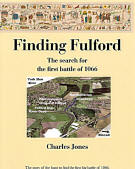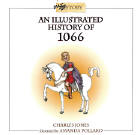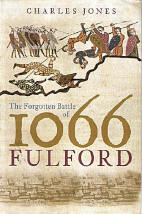All History Guide: Your guide to history on the Internet..
" .. this unusual, and yes, excellent history book.."
"More books like this one introducing historical study in a sympathetic was are needed.."
Now in paperback
... and into its 3rd reprint!
1. Archaeological evidence
1.1. A full report of the work undertaken by the community group is due to be published in late 2006 which will make a strong, evidential case that Germany Beck is the core of the battlefield of 1066. Pending this, an outline report without all the data, analysis or details has been prepared for the public inquiry and distributed with this statement.
- 1.1.1. The raw data and the finds are open for anybody to inspect.
- 1.1.2. It is taking longer than expected to analyse the mass of data. The pre-publication plan calls for those academics who assisted in devising the investigation reviewing the work and this will take time.
- 1.1.3. As a consensus already exists agreement that this is the likely battlesite, we would be happy meet the developer’s archaeological advisor to allow us to present an agreed case to the inquiry.
1.2. All parties have stated that this is the likely location of the battle.
- 1.2.1. The developers in their desktop study noted “The location for the battle
is open to conjecture. The geographical details that the River was to the right
(west) and the Ditch was on the left (east) suggests that the Ditch mentioned
may refer to Germany Beck. This theory was adhered to by K Penn who wrote the
report on the A64 Outer Ring Road evaluation in 1973. Broadhead in his article
gives the location of the battle on Fulford Ings (SE 609488). Without further
field evaluation this issue seems likely to remain unresolved. …. The site of
the battle of Fulford, based on interpretation of the available evidence does
suggest that this event may have occurred either on the site or very close to
the eastern boundary of the site. Whether information relevant to this event
would be forthcoming from the development of the site is difficult to say. …
Considering the results of the evaluation it is recommended that further
evaluation of the proposed development area be undertaken” When this was
written, probably in 1995, the area of Germany Beck did not form part of the
proposed development. In a public debate in early 2001, it was agreed with the
developer’s representative Anne Finney that we both accepted Germany Beck as the
probable battle site so we spent the evening talking about the history of the
area. A decade later, the developer was claiming that “the proposed development
would not appear to impact on the battlefield location due to the total lack of
evidence to support the battle having taken place on the Germany Beck site”
which as various people have pointed out lacks logic and is wrong.
- 1.2.1.1. The absence of proof is not proof of absence and invites the question about why the developers have behaved to prevent gathering the evidence.
- 1.2.1.2. The notion that their plans ‘would not appear to impact on the battlefield’ is incomprehensible. Their plan is to cover it with several metre of hardcore topped with tarmac.
- 1.2.1.3. To their credit the developers have accepted the need to provide a battlefield interpretation trail should their application be approved.
- 1.2.2. Dr Paul Stamper, the Battlefields Panel coordinator for English Heritage, wrote to the city in May 2004 saying ‘The degree of proof which our own criteria require for registration is high – more than tradition or likelihood – and other then in the most exceptional cases such as Hastings is unlikely to exist for such early battle. ..while the available evidence is insufficient to allow the inclusion of the site on the Register of Battlefields, your authority may still be minded to conclude that on the balance of probability it has a significance as the most likely site of this important event.’
- 1.2.3. The city archaeologist wrote in his report to the planning committee “.. the evidence for this being the site of the Battle of Fulford is more difficult to evaluate. It has not been possible to locate and describe features, deposits or indeed the landscape within which the Battle of Fulford took place with any reasonable degree of certainty or accuracy. However, it is inherently likely that the Battle of Fulford was fought in this area.” This advice was offered without the benefit of a site visit or an inspection of the data collected.
- 1.2.4. The exchanges between the city archaeologist (CA) and various officers of English Heritage (EH) is worth noting. CA warns EH in September 2003 (12.2) ‘The supposed site of the Battle of Fulford may lie in part within the proposed housing development..’ CA assessment for EH is that ‘If this interpretation is accepted, and it appears to me to be a reasonable interpretation, the main issues in my opinion is….the acceptability or otherwise of any impacts the development may have on the historic landscape…’ EH to COYC in May 2004 ‘The battlefield of Fulford was clearly of sufficient political and historical significance to merit inclusion of the Register.’ But points out that the evidence so far available to them does not allow it to be ‘securely mapped’ adding that the degree of proof required for the old Register is high. (5.2) It is relevant to point out that the original Battlefield Register was compiled on the basis of tradition and no work had been commissioned to investigate the existing or new battlefields and the system is soon to be replaced by a new register.[1.6.2 below]
- 1.2.5. The Battlefield Trust will be submitting their own statement but it is worth including the comment made by English Heritage when writing to the City Archaeologist that ‘Preliminary work by Glenn Foard of the Battlefield Trust …. confirms the area of the proposed development as a strong possibility for the site of the battle.’
- 1.2.6. Four letters have been submitted to the inspectorate. They come for some
experts on the subject of battlefields who are masters of their subject. They
have all produced popular television series on the subject of battlefields.
- 1.2.6.1. Prof Richard Holmes – Writer and presenter of the ‘Battlefield Walks’ series.
- 1.2.6.2. Dr Tony Pollard – One of the ‘Two Men in the Trench’ who has just established the UK’s first undergraduate course for battlefield archaeology.
- 1.2.6.3. Peter and Dan Snow – Whose ‘Battlefield Britain’ series demonstrate the popular appetite to understand our battlefield heritage.
- 1.2.6.4. Dr Tim Sutherland – Archaeological advisor on ‘Battlefield Detective’ and the lead investigator at Towton.
- 1.2.6.5. They all want to see the site investigated and interpreted for the benefit of the public. All 82 attendees at the International Battlefield Conference in 2002 signed a letter to the city council requesting that no permission is granted until the site has been properly investigated.
1.3. Battlefields are important artefacts.
- 1.3.1. Dr John Carman, University Research Fellow in Heritage Value at The Institute of Archaeology and Antiquity, University of Birmingham has been leading the academic debate about battlefields as cultural artefacts. He highlights the problems associated with preserving battlefields. He has written: “The category of ‘historic battlefield’ is a new category that has emerged from the shadows of archaeology over the last twenty years or so. As an object of specifically archaeological concern it is an interesting and problematic category, although this is not often acknowledged by battlefield archaeologists.”
- 1.3.2. There has been much debate about how to afford protection to battlefields and the various consultative process leading towards a new legal framework has been completed. The responsible government department say that the ‘White paper’ will be published ‘in the late summer’. There is every indication that the site at Fulford will be afforded protection when the new act becomes law.
- 1.3.3. English Heritage has launched a project to define a methodology to investigate battlefields which should make life much easier for the planners of the future.
1.4. Fulford is an important battle as the letters from all the experts illustrates. After criticizing the way that military and social historians have dominated the choice of sites that are rated as important Dr Carmen concludes: “Instead we should be examining not the spectacular, the decisive and the memorable but precisely those ‘strategically piffling, pointless bloodbaths’ that Keegan refers to; these are the more usual and representative battles of any historical period.” The old view of ‘celebrity battles’ is being reassessed. When that process is complete, the relevance of Fulford to the events of the autumn of 1066 can expect to be better appreciated.
1.5. So long as reasonable suspicion is established, any proposal must mitigate against disrupting this important environment at Fulford. This is how the relevant Planning Guidance summarises the importance of archaeology: It is worth quoting in full as it is unambiguous about the value of heritage and the need to avoid its ‘needless and thoughtless’ destruction:
A: The Importance Of Archaeology
“3. Archaeological remains are irreplaceable. They are evidence - for prehistoric periods, the only evidence - of the past development of our civilization.
“4. Today's archaeological landscape is the product of human activity over thousands of years. It ranges through settlements and remains of every period, from the camps of the early hunter gatherers 400,000 years ago to remains of early 20th century activities. It includes places of worship, defence installations, burial grounds, farms and fields, and sites of manufacture.
“5. These remains vary enormously in their state of preservation and in the extent of their appeal to the public. "Upstanding" remains are familiar enough - the great stone circles, the castle and abbey ruins of the Middle Ages or abandoned coastal defence systems. But less obvious archaeological remains, such as ancient settlements and field systems, are also to be found across large parts of the country. Some prehistoric sites in wetland areas contain important wood and organic remains. Many buildings in older towns lie on top of Roman, Anglo-Saxon or medieval structures.
“6. Archaeological remains should be seen as a finite and non-renewable resource, in many cases highly fragile and vulnerable to damage and destruction. Appropriate management is therefore essential to ensure that they survive in good condition. In particular, care must be taken to ensure that archaeological remains are not needlessly or thoughtlessly destroyed. They can contain irreplaceable information about our past and the potential for an increase in future knowledge. They are part of our sense of national identity and are valuable both for their own sake and for their role in education, leisure and tourism.
“8. With the many demands of modern society, it is not always feasible to save all archaeological remains. The key question is where and how to strike the right balance. Where nationally important archaeological remains, whether scheduled or not, and their settings, are affected by proposed development there should be a presumption in favour of their physical preservation. Cases involving archaeological remains of lesser importance will not always be so clear cut and planning authorities will need to weigh the relative importance of archaeology against other factors including the need for the proposed development (see also paragraph 27). Regardless of the circumstances, taking decisions is much easier if any archaeological aspects of a development site can be considered early on in the planning and development control process. This is discussed in Section B.”
1.6. The nature of archaeological investigation on battlefields is new and the approach adopted at Fulford is pioneering.
- 1.6.1. The city archaeologist agrees that ‘there is no accepted methodology for evaluating 11th century battlefield sites.’ But goes on to say ‘it is reasonable to suppose that standard archaeological approaches would have produced some evidence’. (2.1) This assumption is unfounded. Recognised sites such as Hastings and Stamford Bridge have failed to yield conventional archaeological material. Consequently the analysis about the battlefield that follows from the city archaeologist is undermined. Finding a battlefield involves more than digging holes and hoping to find some indicative artefacts. If you added the total area of all the trenches investigated by the developer, it would add up to an insignificant percentage of the battlefield investigation area (<.01%).
- 1.6.2. In order to alert the developers and the city to the emerging techniques for investigating battlefields, the only full-time battlefield archaeologist in England, Glenn Foard was asked to assess the work undertaken by the developers.(2.2) It was highly critical and provided a methodology to investigate the site.(2.3) Sadly all this advice has been ignored.
1.7. It would be wrong to leave the impression that the archaeological work that has been carried out on the site has not been excellent and informative. The effort expended in the area of the housing was appropriate and the results interesting. But this work is of very little relevance to identifying the battlesite. Later we will inquire as to why this same skill and supervision was not applied to the investigation of the battlesite in spite of the advice and eventual complains that were lodged with the planners.
1.8. ODPM asks in the call-in letter also asks if ‘in situ’ is appropriate to this site.
- 1.8.1. A conference was convened last year by English Heritage to reassess the general presumption that preserving sites beneath buildings was the favoured option. While this is a sensible compromise in many cases, it is now clear that this does not preserve all types of archaeology which is leading to a review of this policy.
- 1.8.2. ‘In-situ’ is utterly inappropriate for a battlefield. Indeed is hard to see that burying the landscape below up to four meters of hardcore, capped with tarmac can seriously be interpreted as ‘in situ’ preservation as the term is generally understood. The landscape surface is the battlefield. Burying it beneath a road is not preservation in any sensible interpretation of the word.
- 1.8.3. This is what the planning guidance says. “Once the planning authority has sufficient information, there is a range of options for the determination of planning applications affecting archaeological remains and their settings. As stated in paragraph 8, where nationally important archaeological remains, whether scheduled or not, and their settings, are affected by proposed development there should be a presumption in favour of their physical preservation in situ ie, a presumption against proposals which would involve significant alteration or cause damage, or which would have a significant impact on the setting of visible remains.” (PPG16:27) The guidelines are again clear but being ignored. The visual impact that the access road would have on the battlefield will destroy it. Why is this site regarded as an exception to this clear obligation on the developers and planning authorities?
1.9. A strong objection is once again made that this inquiry is being conducted before the necessary archaeological work and assessment has been undertaken.
- 1.9.1. The arguments set out in the council’s documentation do not provide reason for not demanding relevant work. The need for the work is clearly appreciated because it has been specified in the mitigation required before full approval could be granted.
- 1.9.2. It is hard to understand the logic embodied in the COYCs grant of planning permission that, on the one hand requires the developer to carefully investigative the battle site, while on the other granting them permission to destroy whatever is found.
- 1.9.3. A proper investigation should have preceded any planning decision about this land. Consequently everything else in this paper is fighting to recover from a position where we should not be.
- 1.9.4. Details of the investigation that is still required are listed on the last page of the outline report and findings.
1.10. The universal acceptance, plus the results of the investigations by the society leave little room for doubt that Germany Beck is the place of the battle. It is certainly impossible to allow the planned road to be built until the investigative work, that has been blocked by the developers, is completed and any fragile evidence destroyed.


